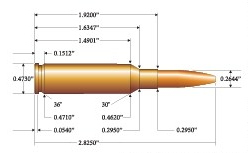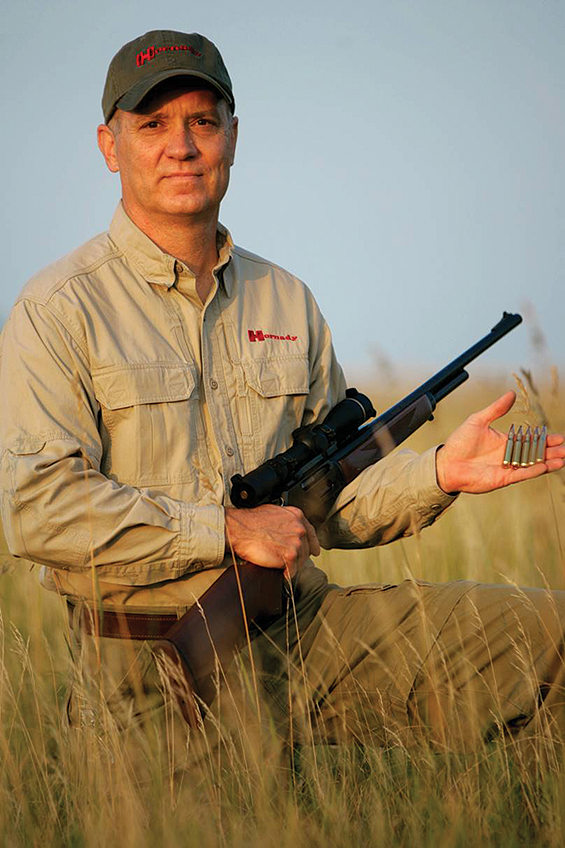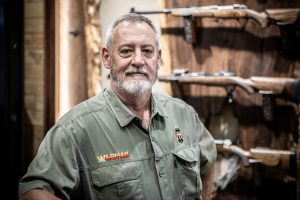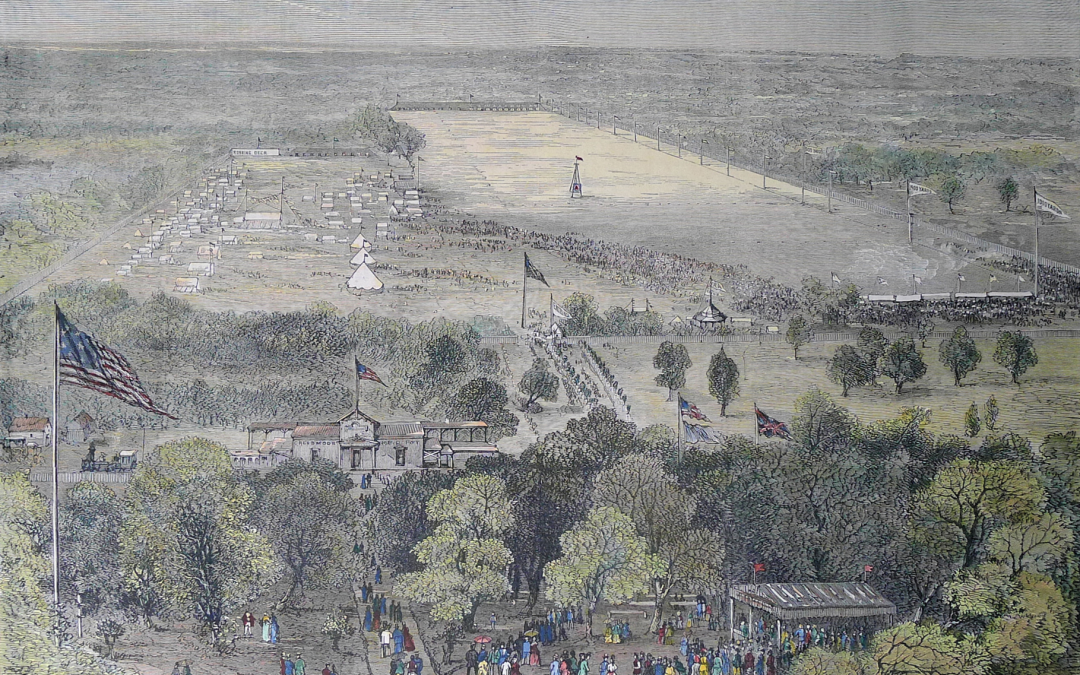This drawing of the Creedmoor Range depicting the venue and the crowd attending a day of competitive shooting between American and British riflemen appeared in the 6 October 1877 edition of The Illustrated London News. In those days, society did not frown upon firearm activities.
By Pierre van der Walt
Cartridge History
American popularity makes or breaks cartridges and calibres. I have always been amazed at the apparent ignorance of Americans about the world of cartridges beyond the .30-30 Winchester, the .30-06 Springfield, .308 Winchester and the .223 Remington. A typical example is 6,5mm cartridges. Americans overlooked the potential of this calibre and its cartridges for 113 years before the penny finally dropped for them. Although cartridges such as the .264 Winchester Magnum and the 6.5 Remington Magnum had been around since 1959 and 1966 respectively, the 6,5mm calibre just did not gain any US traction.
Fortunately, the Americans eventually discovered the existence of some calibres and cartridges beyond the walls of Springfield, Remington and Winchester. This is an excellent development, because for all other American shortcomings, American buying power has been the decisive factor in the survival of the firearm and cartridge industries.
The 6.5 Creedmoor is an example. It emanated from a discussion between Hornady’s Dave Emary and High-Power National Champion, Dennis DeMille on the problems experienced by 6mm wildcat users at the 2007 Camp Perry National Matches. They concluded that a modern, SAAMI regulated commercially produced cartridge that was capable of winning National Matches was needed. The 6mm calibre could obviously not achieve that. Emary and his engineering colleague, Joe Thielen, opted to step up from the 6mm to the 6,5mm calibre with its higher ballistic coefficient potential. Their goal was to create a short-action cartridge capable of supersonic velocity out to 1,200 yards while adding the minimum recoil, and they succeeded.
The Creedmoor name is steeped in long-range tradition. Let us step back in history to the post American Civil War era. The statistics indicated that Union Army soldiers only hit one Confederate soldier out of every thousand shots fired during the war. This was a great concern and it was decided to establish an organisation dedicated to the improvement of American marksmanship. The organisation, dubbed the National Rifle Association of America (NRA), was established in New York on 16 November 1871. During 1872, the fledgling body succeeded in convincing the New York Legislature to contribute US$ 25,000 to purchase 70 acres (28,3 ha) of farmland from a Mr Creed, for development as a long-distance
Technical Specs
| First Regulator | SAAMI |
| Introduced | 2007 |
| Country | USA |
| Relative Case Capacity | 53.5 gr water (3,474 cc) |
| Case Trim Length | 1.912” (48,57 mm) |
| Expansion Ratio | 7.8 |
| Groove Diameter | .2640” (6,71 mm) |
| Bore Diameter | .2560 (6,50 mm) |
| Groove Details | 6 x .0900” (2,29 mm) |
| CAB-Ratio | 71.8 |
| Minimum Barrel Area | 0.0536”² (34,58 mm²) |
| Std Proof Barrel Twist | 1:8.0” (1:203 mm) |
| Max Average Pressure | 62,000 psi (427Mpa) |
| RCBS Shellholder | 3 |

rifle range. When a Colonel Shaw, one of the NRA range committee members first saw the piece of land, he said that it reminded him of a moor. So, it became known as Creed’s Moor and later, simply Creedmoor.
The Creedmoor range was officially opened on 21 June 1873 and soon hosted historic competitions such as the famous one between the NRA and the Irish Rifle Team (which included the eminent John Rigby) in September 1874.
It is therefore rather fitting that Emary and Thielen’s dedicated long-range match cartridge, the first commercial rifle cartridge ever specifically conceived and designed for extreme range competition, was dubbed the 6.5 Creedmoor.
It took a while before the 6.5 Creedmoor captured the imagination of the American shooting fraternity, but when the 6,5mm penny finally dropped, it did so big time. Today the 6.5 Creedmoor is the best-selling long-range, match cartridge on the planet.
Characteristics
The 6.5 Creedmoor is an indirect sibling of the .308 Winchester. In 1982 Winchester introduced the .307 Winchester cartridge as a rimmed version of its .308 for the Winchester M-94 Big Bore lever action. The concept did not catch on, but around 2007 the Thomson Center company requested Hornady to create a .30 calibre cartridge for its then new Icon bolt action rifle. Hornady’s Dave Emary is said to have modified the .307 Winchester case by thinning its case walls, shortening it and turning it into rimless configuration to create the .30 TCU cartridge. Both the .307 Winchester and .30 TCU have now fallen by the wayside. The 6.5 Creedmoor is said to have been created by necking a .30 TCU cartridge down to 6.5mm by means of a 30° shoulder. I find this a bit strange, as it would have been simpler to use the .308 Winchester case.
The 6.5 Creedmoor has 0.37° body taper and a 30° shoulder, as opposed to the .260 Remington’s 0.69° body taper and 20° shoulder. Despite the Creedmoor being 0.115” (2,92mm) shorter than the .260 Remington, these features, combined with thinner case walls resulted in the .260 Remington beating the Creedmoor by just shy of 4% in the water capacity stakes. The 6.5 Creedmoor has the advantage of a 107.6% of calibre neck as opposed to the Remington’s 97.9% neck.
This all sounds as if the 6.5 Creedmoor is way ahead of the .260 Remington and in factory format it does indeed lead, but there is a lot that can be done to ‘improve’ the .260 Remington. For example, if both cartridges are loaded to the same overall length (2.825”) and the same pressure level (62,000 psi – 428 MPa), the performance outcomes actually favour the .260 Remington. The margins are so small however that I have come to consider the two cartridges identical performers.

Dave Emery has since retired, but he was one of the conceivers of the 6.5 Creedmoor and played a crucial role in its development. Dave was also involved in the design of several other cartridges during his tenure at Hornady Manufacturing.
It is commonly claimed by retweeting gunwiters that the tighter twist of the 6.5 Creedmoor and its ability to stabilize heavier bullets than the .260 Remington is what gives it the edge. That may be so when used across bush-ranges (≤ 150 yards) and when using 156 – 160 grain bullets. Truth is – nobody uses the Creedmoor in that fashion. The Creedmoor is used across extended ranges in both match and hunting application. It is so rare to find any hunter using bullets heavier than 143 grains for any application, that it can effectively be discounted as an advantage or consideration.
The CaB-Ratio of the 6.5 Creedmoor is 71.8 and the Expansion Ratio 7.8. That is middle of the road for both features and translates to reasonable barrel life. The Creedmoor’s CIP ‘S’ measurement or gas turbulence point is inside the case neck – even if barely so. If that is indeed beneficial as claimed by some, I find the position too precariously close (0.03” – 0,76mm) to the mouth to render a truly tangible benefit. An aspect that counts in favour of the Creedmoor is that it usually requires less of a given propellant than the .260 Remington for comparable performance. I compiled a VC Comparison table from the load data tables. According to the data used the Remington requires 2.1% more propellant to achieve a 3 fps (0.11%) velocity advantage. The Creedmoor’s conversion of propellant to velocity (Velocity ÷ Charge) ratio is 1.9% better in the example used. All this means that a 6.5 Creedmoor is the more efficient and that Creedmoor barrels should last to around 2,000 shots in competition and 3,000 for hunting use.
| Bullet | Propellant | 260 Rem | 6.5 Creedmoor | ||||
| Weight | Type | Charge | Velocity | V/C | Charge | Velocity | V/C |
| 160 | H-4350 | 43.0 | 2538 | 59.0 | 40.6 | 2500 | 61.6 |
| 150 | H-4350 | 42.0 | 2635 | 62.7 | 41.2 | 2638 | 64.0 |
| 140 | H-4350 | 42.2 | 2755 | 65.3 | 42.3 | 2731 | 64.6 |
| 130 | H-4350 | 42.7 | 2816 | 65.9 | 43.0 | 2800 | 65.1 |
| 120 | H-4350 | 46.5 | 2960 | 63.7 | 45.0 | 3022 | 67.2 |
| Average | 43.3 | 2741 | 63.3 | 42.4 | 2738 | 64.5 |
Performance & Application
Handload Performance Figures at 100% Bullet Expansion (24.0” Barrel)
| Bullet | Velocity | Muzzle | RTP | RTP | RTP | RTP | Recoil |
| Weight | Threshold | Energy | Muzzle | 100 yd | 200 yd | 300 yd | 8 lb Rifle |
| 160-grain | 2,575 fps | 2,356 ft/lb | 35.1 | 30.7 | 26.6 | 23.0 | 16.4 ft/lb |
| 156-grain | 2,625 fps | 2,387 ft/lb | 35.6 | 31.6 | 28.0 | 24.7 | 16.6 ft/lb |
| 150-grain | 2,700 fps | 2,429 ft/lb | 36.2 | 32.0 | 28.2 | 24.7 | 16.9 ft/lb |
| 143-grain | 2,775 fps | 2,446 ft/lb | 36.5 | 32.0 | 27.9 | 24.3 | 16.9 ft/lb |
| 140-grain | 2,800 fps | 2,438 ft/lb | 36.4 | 31.7 | 27.5 | 23.8 | 16.9 ft/lb |
| 135-grain | 2,850 fps | 2,435 ft/lb | 36.3 | 31.6 | 27.3 | 23.5 | 17.0 ft/lb |
| 130-grain | 2,900 fps | 2,428 ft/lb | 36.4 | 31.1 | 26.7 | 22.7 | 17.1 ft/lb |
| 123-grain | 2,950 fps | 2,377 ft/lb | 35.5 | 30.1 | 25.3 | 21.2 | 17.4 ft/lb |
| 120-grain | 2,975 fps | 2,439 ft/lb | 36.4 | 30.7 | 25.7 | 21.4 | 17.6 ft/lb |
| 110-grain | 3,125 fps | 2,399 ft/lb | 35.6 | 29.1 | 23.7 | 19.1 | 17.6 ft/lb |
| 100-grain | 3,225 fps | 2,310 ft/lb | 34.4 | 27.2 | 21.3 | 16.5 | 16.3 ft/lb |
Averaged CSM = 5.29 lb (2,40 kg)
The bullets used for the calculation of the RTP (Relative Trauma Potential), and the Green-Band are quality hunting bullets, not extended range, high ballistic coefficient paper punchers. The hunting bullets used, drop below 2,600 fps at the end of the Red-Band, below 2,200 fps at the end of the Green-Band and below 2,000 fps where the Amber-Band ends.
The 6.5 Creedmoor is a great extreme range match cartridge, but for hunting it’s just a 350-yard option and can be stretched to 500 yards given a carefully selected bullet. That disregards my half-second time of flight principle. The needs of hunters differ massively from that of the extended range target shooter. The latter is not at all concerned about terminal ballistics. Their concerns are with external ballistics, not terminal ballistics. Sport shooters want to minimize time of flight, achieve the flattest trajectory possible and extend the supersonic velocity of the bullet as far as possible.
Whereas the 140-gr hunting bullet used in the tables fall below 2,000 fps at around 475 yards already and goes subsonic around 1,225 yards. A Berger 140-gr Match Hybrid Target bullet will, for example, only do so at around 585 and 1,575 yards respectively, depending on altitude and atmospheric conditions.
Hunters are concerned with reliable expansion, bullet integrity, wound channels and venison destruction. It is so that Karamojo (Walter Bell) hunted elephants with a 6,5mm cartridge in days gone by, but let’s be honest; none of us is Karamojo Bell and times have changed. We should use cartridges within more realistic parameters.
A realistic approach is that he 6,5mm cartridges are small game cartridges best suited to species weighing up to 330 lb (150 kg) on the hoof.

Handloading
Hornady, Peterson, ADG and Lapua are the leading manufactures of cases for the Creedmoor. Hornady’s have standard large rifle primer pockets while Lapua offers both large and small rifle primer pockets.
I am not convinced small primer cases indeed deliver better precision than large primer cases, but as far as I’m concerned, that is only relevant for extreme range precision. Even competitive shooters are at odds about the matter. When you investigate this aspect, it becomes obvious that small primer preferring shooters are pushing the Creedmoor beyond specification. So, we are facing the same

The other big name in the development of the 6.5 Creedmoor was Joe Thielen, also of Hornady. Here Joe is with a nice nyala bull he bagged.
situation with the Creedmoor as the 6mm situation that led to its creation! The high pressures generated by pushing the cartridge beyond specification stretch the primer pockets rather quickly. To strengthen the case head and improve case web integrity, Lapua opted to leave more brass in the area by opting for the smaller primer option. I remain a sceptic.
What I can confirm is that case volumetric consistency and case neck tension are major contributors to long-range precision. Lapua cases are extremely consistent out of the box and should be case of choice for the precision shooter. To extract the utmost precision from the 6.5 Creedmoor, rigorous case classification of neck wall consistency and water capacity should be applied. That must be followed by dedicated case preparation steps such as primer pocket uniforming, flash hole deburring, neck turning and regular annealing. So are the use of a top-class press, competition dies and loading techniques.
The 6.5 Creedmoor works with a variety of slow-burning propellants in the H-4350 to H-4831 bracket with all bullet weights. Vihtavuori is the one company that developed a dedicated 6.5 Creedmoor propellant: N-555. It burns between the two Hodgdon/ADI propellants mention above.
| Bullet | Propellant | Min | Max | Max | Barrel | Data |
| Weight | Type | Load | Load | Velocity | Length | Source |
| 160-gr Bullet | Accurate AA-4350 | 37.0 | 39.8 | 2450 | 24.0” | Hornady Handbook. 9th Ed. 2012 |
| Alliant Rel-15 | 34.0 | 37.2 | 2450 | 24.0” | Hornady Handbook. 2021 | |
| Hodgdon H-4350 | 37.5 | 40.6 | 2500 | 24.0” | Hornady Handbook. 2021 | |
| HodgdonVarget | 33.4 | 35.2 | 2400 | 24.0” | Hornady Handbook. 2021 | |
| IMR-4350 | 37.7 | 40.5 | 2600 | 24.0” | Hornady Handbook. 2021 | |
| Norma URP | 37.0 | 39.9 | 2500 | 24.0” | Hornady Handbook. 2021 | |
| Norma N-203 | 33.6 | 36.7 | 2450 | 24.0” | Hornady Handbook. 2021 | |
| Ramshot BigGame | 36.8 | 40.2 | 2500 | 24.0” | Hornady Handbook. 2021 | |
| Somchem S-385 | 41.5 | 44.0 | 2600 | 24.0” | Handload. Not pressure tested | |
| Somchem S-361 | 41.5 | 43.6 | 2526 | 24.0” | Handload. Not pressure tested | |
| Somchem S-365 | 39.9 | 41.8 | 2600 | 24.0” | Handload. Not pressure tested | |
| Somchem S-355 | 34.1 | 36.4 | 2525 | 24.0” | Handload. Not pressure tested | |
| Winchester WW-760 | 40.0 | 42.9 | 2550 | 24.0” | Hornady Handbook. 2021 | |
| Winchester WW-748 | 34.4 | 36.5 | 2400 | 24.0” | Hornady Handbook. 2021 |
Bio
Pierre van der Walt grew up on a farm and began hunting from a very young age. He was just ten years old when he took part in his first lion hunt and captured a cub to keep as a pet. During the Angolan War, he served as a combat officer, and subsequently qualified as both a lawyer and a professional hunter. He published his first firearm article in 1992 and has since become Africa’s most prolific outdoor writer. In 2023, he was awarded the John T. Amber Literary Prize by the US publication Gun Digest for an article on the history and evolution of Czech hunting rifles. He has published four books that are internationally recognised as definitive works on hunting cartridges within the African context, and co-authored The Complete Professional Hunter’s Handbook, which is used as the official manual for professional hunter training in South Africa.

What was said about –
African Small Game Cartridges
African Small Game Cartridges is the third book in the author’s highly acclaimed series on hunting cartridges for Africa. Just like his previous two books (African Dangerous Game Cartridges and African Medium Game Cartridges), African Small Game Cartridges, is the most comprehensive ever discussion of the cartridges covered.
Like the previous books, it is destined to become yet another reference standard, which will serve the international and African hunting, shooting and reloading fraternities for decades. A generous part of African Small Game Cartridges is dedicated to relevant topics such as barrel life, understanding riflescopes, suppressors, and ballistic coefficients.
This coffee table quality reference work extends 480 pages with 350 excellent full colour images and countless performance tables of Africa’s 33 currently most popular .172, .224, 6mm, .257 and 6,5mm hunting cartridges. It takes readers on a grand tour of their history, specifica tions, design features, performance and field application, as well as the reloading quirks of each of these cartridges. African Small Game Cartridges provides unequalled data – around 7,200 loads for American, Australian, African, European and Scandinavian propellants.
International experts have made the following comments about this book
Johan van Wyk (Australia),Editor of SA Hunter magazine
Hunters and shooters are constantly bombarded by marketing onslaughts from all corners, each pretending to be punting the greatest cartridge or item. While progress cannot be halted, we need to sort the wheat from the chaff, especially for the more novice amongst us. With two authoritative books already under his belt, Pierre van der Walt is well qualified to not only steer the inexperienced in the right direction, but to also provide plenty of food for thought for the experienced. I unreservedly give African Small Game Cartridges the thumbs-up. It is well researched and a worthy addition to any shooter’s gunroom.
Mats Bergholm (Sweden) Weapon Systems Expert – Swedish Defence Materiel Administration (FMV)
Pierre van der Walt has done it yet again! His first book, African Dangerous Game Cartridges, is the definitive tome about calibers for Africa’s biggest and deadliest. This book, African Small Game Cartridges, Pierre’s third, is nothing short of a masterpiece. It covers the tiniest ‘African’ calibers, but it is as fascinating from a northern European perspective. The calibers presented also cover calibres used for northern European game hunting, from grouse to elk and non-Africa focused hunters world-wide will benefit equally from this book’s overabundance of information. It fits just as well as a coffee table book in a Swedish moose hunting lodge as it does at a game lodge on the banks of the Limpopo River.
Ira Larivers (Zimbabwe) Editor African Hunter Magazine
Unequalled! The subject matter in this book fills a gap in Africana and international literature. The fact that it was written by the master of the genre, Pierre van der Walt, makes it essential reading. Apart from crucial calibre choices, he also covers many other important topics. Everything is very well presented. It includes a detailed appraisal of the 33 Africa popular small game cartridges, plus some lesser-known gems such as the .224 African. African Small Game Cartridges offers unprecedented cutting-edge information and a myriad of high-quality photos in a lasting format. Don’t miss out.

